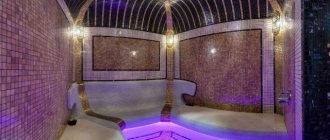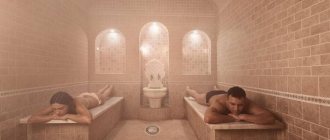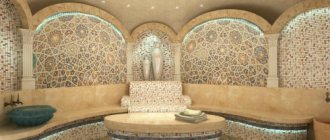Features of the hammam bath
Hamam is a traditional Turkish bath, which provides a completely different approach to water procedures. If you try to compare a hammam with a Russian bath, then the first one will notice the low temperature regime. Under conditions of 100% humidity, the temperature in the bathhouse does not rise above 50 °C . Because of this, the traditional Turkish bath is popular among those people who, due to health conditions, cannot tolerate high temperatures. High humidity also has a healing effect, without overloading the body.
As a result of creating similar conditions in a Turkish bath, water and temperature more carefully cleanse the skin, allowing the supports to fully open, and saturate it with moisture. A visit to the hammam not only improves the condition of the skin, but the body itself begins to work like a clock. There is no need to waste time and effort preparing and steaming the broom. Visiting a hammam bath without special accessories allows you to experience an incomparable feeling of bliss.
The main health effects that are observed after visiting the baths
When visiting the hammam, a general cleansing of the body occurs; you will immediately feel the fatigue go away and the pain that arises from overstraining some muscles or curvature of the spine due to incorrect body position receding. After a SPA procedure, the oxygen saturation system of the whole body stabilizes, colds recede and body temperature decreases. With systematic visits to baths under the supervision of an experienced specialist, you can fight insomnia and stabilize the functioning of the digestive system.
The qualified staff of the SPACOCKTAIL SPA center practices an individual approach to each client, attentive attention to his problems and exceptional tact. By offering wellness treatments such as a visit to the hammam, today we give every visitor the opportunity to experience the healing effects of a centuries-old tradition. After visiting the steam room, cosmetic procedures become more effective. It is especially useful after steaming to carry out various peelings, as well as subsequent wraps, since steamed heated skin is easier and more comfortable to clean, the pores breathe and absorb to the maximum the valuable substances included in face and body masks. That is why our salon has included a visit to the Cleopatra steam cabin in almost every SPA program.
In the comfortable aquathermal zone you will be offered various types of relaxation and wellness, ideal for communicating with family and friends.
To get to our aquathermal zone, just choose one of our SPA programs or visit it separately in our salon, signing up for the desired duration.
The origins of the ancient tradition
The first baths in Turkey began to be built at the beginning of the 17th century . If we turn to the chronicles, the Turks adopted their first experience in maintaining personal hygiene from the Arabs, and they received their secrets from the ancient Romans. Many historians provide quite convincing evidence in favor of the fact that the hammam became a unique national variation of the Roman baths.
Interest in hammam baths began to increase at the time when Islam came to eastern countries. The baths became so popular that sometimes ancient temples of other religions were even converted into them. It was necessary to carry out rather labor-intensive work to re-equip the premises in order to comply with the requirements of multi-stage procedures. They were changed to such an extent that the baths in every detail exactly corresponded to the Turkish style .
Continuing to get acquainted with the history of the hammam, you can find out that the first examples of these baths did not have significant advantages. But the years passed, and traditions of visiting Turkish baths gradually formed. A clear confirmation of this was the steam room, which turned into a place for massage. This was an innovation for the hammam - there was no such thing in the Roman baths. The necessary changes were made to the dry steam room, as a result of which it turned into a “sweating room”.
Today, in our country, you can find Turkish hammams, but, as happened with other types of baths, these were just clones, unable to provide the required effect. Therefore, if you want to feel the bliss of visiting a real hammam, then you should go to Istanbul or Bukhara , where classic hammams are still preserved. In these cities, long-term buildings still continue to function, which the owners monitor and do not even think about making changes to them.
Algorithm for working on walls, ceilings and floors
- We install waterproofing over the entire area;
- we insulate with special materials that are not afraid of moisture;
- We put foil insulation on top for optimal heat retention in the room;
- we install basic communications;
- we make screed on the walls, ceiling and floor;
- carefully plaster the surface;
- we apply the final waterproofing using the membrane mentioned above;
- We do the finishing with ceramic tiles or natural stone;
- You can additionally decorate the walls with wood carved bath panels, but it is important to choose the right pattern in order to logically fit into the oriental theme.
Classic bath treatments
If you follow the traditions of building baths in the hammam style, then Turkish baths are made in the form of one large building, including many rooms and utility rooms. A large water boiler is used as the only heating device, which can be built into the wall or installed in the underground space.
One of the features of the hammam is the presence of special holes in the walls of the steam room at a height of approximately 1.5 m . Hot air enters the rooms through them. It is possible to maintain a special atmosphere in the steam room due to the supplied heated steam, which comes through pipes under the floor from the boiler. Therefore, to walk barefoot on the floor, you need to wear special shoes.
In the traditional version, the Turkish bath hammam is made in the shape of a human hand. There is no need to make changes to the dimensions of the bath rooms, since they are optimal and were thought out many centuries ago.
The central room is the steam room, around which there are five separate rooms that symbolize the number of fingers.
The entrance is the dressing room, which means hand . In this room the temperature does not rise above 35 °C. The dressing room is used to warm up and prepare the body for the sacred ritual. In a hammam, the steam room is always made in the form of a spacious room, in the center of which a marble lounger is installed - “chebek-tashi”. If you try to translate the name literally, you get a “belly bed.” Therefore, you need to rest on a lounger with your back up. There are legends that marble is a special material with unique properties, thanks to which, in conditions of high temperatures, it can expel minor ailments from the body, primarily from the intestinal tract.
From the steam room there is a path to five corridors, through which you can enter the remaining rooms, where each is maintained at a different temperature . As a person moves from one room to another, the body is subjected to a certain load, which allows it to cleanse the body of toxins. If you walk along the corridors, it may seem that every area has an electric heating system. However, this is a misconception. The unique effect is ensured by a properly positioned heating boiler.
There is an ancient prediction that if you go through all the rooms, you can completely rid your body of any ailments. At the end of the cycle, you need to go back to the steam room and enjoy a traditional massage performed by oriental masters. Those who are about to subject their body to this procedure for the first time initially compare it to torture. However, the first impression is deceptive, and after the procedure is completed, it becomes clear that the “victim” enjoyed such a beating. This can be explained by the truly healing effect of a real Turkish massage, which can relieve fatigue , clear the mind and invigorate the entire body.
After the massage, visitors will have to go one by one to pools with different temperatures and wash in them using a hard washcloth. This procedure is the result of borrowing from the Roman baths, which was left in its original form in the Turkish bath.
Minimum amount of free space
Since the steam generator must be located in a separate room, it becomes necessary to allocate space for it. 1 square meter is enough , but the technical room also requires isolation from the steam room.
A comfortable steam room for 1-2 people can be arranged on an area of 3 square meters.
Experts also recommend thinking about a relaxation room, but this is more likely just a wish, and not a prerequisite.
A modern take on the Turkish bath
The modern hammam offers far different procedures than those performed many centuries ago. Even resort towns fail to impress connoisseurs. The fact is that to create the required temperature conditions, steam generators are used for the bath, which are carefully hidden with the help of beautiful interior decoration.
This situation has arisen due to the fact that today in Arab countries few people show such a high interest in traditional ablution. Tourists who even agree to such a bathhouse do not have much choice. And in principle, modern hammams are mostly just small saunas. And all because it is incredibly difficult to build such a serious structure as a Turkish hammam on a tiny plot.
But recently there have been positive changes in our country. Increasingly, you can find hammams that are no longer the same ones that could previously be found in almost every major city. Now you can undergo the procedure of ablution in a Turkish-style bath in various sanatoriums and health centers .
Hamam architecture
The hammam is built according to the palm principle, that is, in plan the room is a structure that consists of five rays emerging from one center - niches (eivans).
The oldest hamams were built by the Umayyad caliphs, who ruled the Arab Caliphate from 661 to 750 and lived a Bedouin lifestyle. Therefore, the first baths appeared not in cities, but in the wild desert. Kusair-aman, one of the oldest hammams that have survived to this day, unexpectedly opened up to the gaze of a traveler in the middle of a waterless desert on the shores of the Dead Sea, surrounded by a blooming garden.
This oasis once also housed a castle for arriving guests and a watchtower, the ruins of which are now almost razed to the ground.
With the spread of Islam, hamams appeared in Iraq, Central Asia, and North Africa (from Egypt to Morocco). During the period of Arab rule in Spain, many eastern baths were built there, and very often castle towers, palaces, and churches were rebuilt for these purposes. The number of hammams compared to the size and density of the then population was truly enormous. In the 9th century, there were 5,000 baths in the eastern part of Baghdad alone. There were 10,000 baths throughout Baghdad already in the first half of the 10th century. Later, the number of hamams began to decline mainly due to their qualitative changes. In the second half of the century, there were reportedly again "only" 5,000. Later, the number of baths steadily decreased, and in the 12th century there were only 2,000 left. The same thing happened in Egypt: in Old Cairo there were about 1,170 hot baths, and in New Cairo in 1286 only 80.
By this time, a specific architectural style of the hammam had formed. Many buildings are luxuriously decorated with mosaics; the interiors often have fountains and pools with water of varying temperatures. The Muslim ban on the depiction of living creatures contributed to the appearance of oriental ornaments, stunning in their ghostly and mysterious beauty, which abundantly decorated the entrance and interior of hammams.
In many regions, following the example of the Romans, the Arabs built hammams at hot springs. They were called kaplika, or ilika. There was no stone pedestal for massage in their hot rooms. The room was heated with water from springs. The oldest kaplikas and ilikas in the East are located in the city of Bursa.
Modern steam room in oriental style
A new approach to the construction of the Turkish hammam made it possible to create completely new baths. It now includes only three rooms. This solution was proposed by engineers in order to simplify construction work, as well as solve the issue of choosing a material. In ancient times, the hammam was built exclusively from stone. Now, as a modern alternative, they use standard brick with original interior decoration in an oriental style .
- The first room is the locker room (jamekian). It is intended not only for warming up the body, but also for taking a shower.
- Behind it comes the steam room. A place that, according to ritual, is used for taking hot baths. After a sufficient stay in the steam room, the effect of medium temperature and high humidity appears, the skin pores begin to open. At this point, you can begin the ablution procedure using a coarse goat's hair washcloth. The body is periodically rubbed and then rinsed with warm water in between.
- Next, visitors are invited to go to the third room (soguklyuk). In it, due to the lower temperature regime, you can cool the body and restore well-being after enduring stress.
And although modern Turkish baths are not very similar to traditional Turkish hammams, the premises still have a familiar configuration , and they are decorated with materials characteristic of the Turkish style. The inside of the bathhouse is decorated using only natural stone. Wood cannot be found in a real hammam.
A characteristic feature of Turkish baths is the oriental style in which the interior of the premises is decorated. Moreover, options are possible here - the design can be rough or clearly strict. Not least important is the lighting in the bathhouse. When choosing lamps, you need to pay attention to the architecture of the building, not forgetting about safety.
Everyone who has visited a hammam pays attention to the ceiling in the steam room. This is a real architectural masterpiece. According to construction rules, it must meet certain requirements:
- Have a dome shape;
- It must reach a height of at least 3 m.
But these requirements are not just a recommendation, but a practical necessity. Round walls do not allow condensation to fall onto the floor ; moisture immediately flows down into the drainage system.
Integration of qurna and massage bed
If you want to bring your improvised hammam as close as possible to the standards of a Turkish bath, then you definitely cannot do without a kurna and a massage bed. Kurna is a special container into which aromatic solutions for massage are placed.
Nearby there is a bench or sunbed reinforced with a foundation. It must support at least 2 people. It will also be used for massage. It’s great if you have a broom made of bamboo sticks - the result will be amazing. Typically the following dimensions are recommended:
- height - 0.8 meters;
- length - 2.1 meters;
- width - 1.2 meters.
You can simply relax on the bench or give a massage to your neighbor. It is ideal if it is decorated with stone or tiles, and the body does not slip on it. But it doesn’t matter if slipping is still present: you can cover it with a special rug.
If you want more convincing, you can decorate the lounger with sea pebbles. It will turn out very authentic and attractive!
The benefits and harms of visiting the hammam
No matter what people say, the hammam, like other baths, can bring both benefit and harm to a person. Therefore, first, it would not hurt for everyone to learn about the beneficial and harmful effects of this bath.
How is hammam useful?
No matter what kind of bathhouse we are talking about, visiting it is sure to benefit the body. The Turkish hammam is no exception. Its healing effect is provided by moist, soft vapors that improve the functioning of the nervous system, sleep, prevent headaches , and have a calming effect. After visiting the hammam, a person’s vitality and metabolism increase. Positive changes occur in the skin, which becomes more youthful in appearance.
Contraindications
No matter how useful the hammam is, it is not for everyone. But unlike other baths, it has fewer contraindications, which is associated with soft, moist steam. Therefore, if, due to your health condition, you cannot enjoy water procedures in a Russian bath or Finnish sauna, where a fairly high temperature regime prevails, then you can easily afford to go to the hammam. If we talk in more detail about contraindications, then the following diseases can be considered as such:
- inflammatory processes of internal organs (at the active stage);
- oncology;
- cardiovascular diseases.
The above list of contraindications clearly shows that the restrictions for visiting the hammam are not so significant when compared with other types of baths. At the same time, visiting a Turkish bath brings significant benefits to the body, which is confirmed by numerous studies by specialists.
Video description
Finnish sauna: benefits and harms, contraindications.
When is it advisable to visit the sauna?
Construction of a sauna in the private sector will be justified if necessary:
- deoxidize the body, that is, remove toxins;
- get rid of stress and fatigue;
- increase performance;
- strengthen the immune system and vascular system;
- stabilize the function of the upper respiratory tract;
- eliminate overtraining (typical for athletes).
Regular stay in a Finnish sauna guarantees relief from chronic diseases of the respiratory system.
Sauna for relaxation and strengthening the immune system Source na-dache.pro
Beliefs associated with the hammam
There are beliefs associated with the hammam. Today, few people believe in them, but they serve as a good way to attract tourists. It is believed that the genies living in the waters of the springs love the peace and quiet of the hamam, so together with the running water they get here and then rise to the ceiling along with clouds of steam. The genie can play pranks: slap a person on a wet body with a loud sound, slap him in the face, as a result of which his voice will disappear, or trip him up, so much so that the person falls and breaks his jaw. If a visitor sees a genie, etiquette instructs him to pronounce a spell, which means “in the name of Allah.” This will cause the genie to leave. According to some beliefs, the devil lives in the hamam. To avoid meeting him, you should not visit the bathhouse during and between the penultimate and last prayers, because at this hour the devil is hovering there along with his friends. To protect the hammam from evil spirits, a special sign was often depicted on the doors. Sometimes a cross was used as an “anti-devilish” sign.











